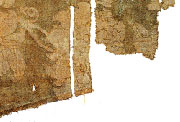 |
 |
|||||||||||||||||
 |
||||||||||||||||||
 |
||||||||||||||||||
| Classified Glossary | ||||||||||||||||||
 |
||||||||||||||||||
 |
||||||||||||||||||
| 40. 1Straight stitch Straight stitch (zhizhen) looks like a short straight line and comes in the form of running stitch (zhizhen), back stitch (jiezhen), split stitch (pizhen), all of which are found at latest on Liao dynasty embroideries of 10th to 11th century. Parallel straight stitch or free straight stitch (sanzhizhen) were also seen in later periods. 41. 1Satin stitch Satin stitch (pingzhen) is the most common stitch in Chinese embroidery, becoming popular in the late Tang dynasty, and further developed from the Song to Qing dynasties. Variations include flat stitch (qizhen), long and short stitch (taozhen), layered stitch (qiangzhen), and turning stitch (xuanzhen). Satin stitch enclosing padding underneath is padded satin stitch (tianchongpingzhen or tianxiu), which appeared in the Ming dynasty. And free satin stitch or random stitch (luanzhenxiu) is a newly developed method by Yang Shouyu, Changzhou, in 1920s. 42. 1Couching Couching (dingzhen) a single or double thread is fastened by a finer thread on the textile with a holding stitch to form the pattern. The names for couching methods vary according to different threads being used, for instance, gold couching embroidery (cujinxiu or panjinxiu) for that with only gold threads, and gold couching on satin embroidery (yajincaixiu) for couching over satin stitch. Couching was used in the Tang dynasty first, then widely applied in the Liao and Jin dynasties. |
||||||||||||||||||
| THE BOOK | ||||||||||||||||||
| AUTHOR | ||||||||||||||||||
| CONTENTS | ||||||||||||||||||
| ORDER | ||||||||||||||||||
| CONTACT | ||||||||||||||||||
| LINKS | ||||||||||||||||||